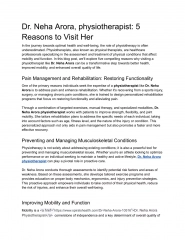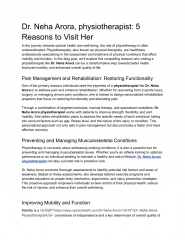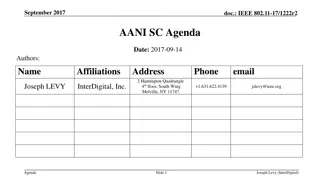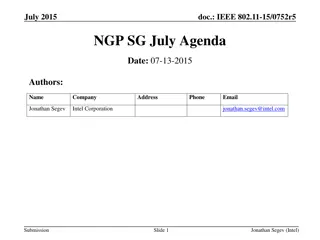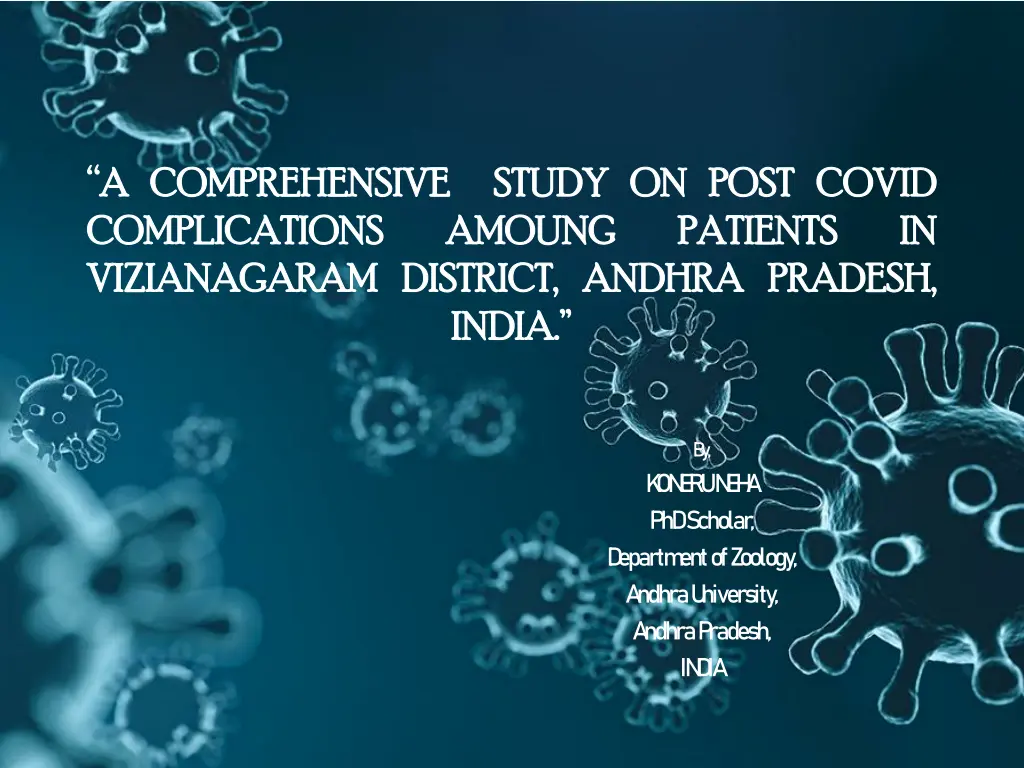
Post-COVID Complications Study in Vizianagaram District
A comprehensive study conducted in Vizianagaram District, Andhra Pradesh, India, focusing on post-COVID patients' complications such as pneumonia, mucormycosis, and the impact on individuals with diabetes and obesity. The research delves into understanding the frequency, risk factors, and manifestations of post-COVID syndrome, shedding light on the complexities of the disease post-acute illness. The methodology involved an epidemiology questionnaire survey to observe the outbreak of complications emerging 3-6 months after the initial COVID-19 infection.
Download Presentation

Please find below an Image/Link to download the presentation.
The content on the website is provided AS IS for your information and personal use only. It may not be sold, licensed, or shared on other websites without obtaining consent from the author. If you encounter any issues during the download, it is possible that the publisher has removed the file from their server.
You are allowed to download the files provided on this website for personal or commercial use, subject to the condition that they are used lawfully. All files are the property of their respective owners.
The content on the website is provided AS IS for your information and personal use only. It may not be sold, licensed, or shared on other websites without obtaining consent from the author.
E N D
Presentation Transcript
A A COMPREHENSIVE COMPREHENSIVE COMPLICATIONS COMPLICATIONS VIZIANAGARAM VIZIANAGARAM DISTRICT, STUDY STUDY ON AMOUNG AMOUNG DISTRICT, ANDHRA INDIA INDIA.. ON POST POST COVID PATIENTS PATIENTS ANDHRA PRADESH, COVID IN IN PRADESH, B y, K ON E RU N E H A PhD Scholar, D epartm ent of Zoology, A ndhra U niversity, A ndhra P radesh, IN D IA
CONTENTS INTRODUCTION METHODOLOGY CONCLUSION REFERENCES
INTRODUCTION After more than year of the COVID-19 pandemic, many aspects of this new and complicated disease are still poorly understood and characterized [5,6], such as the frequency and risk factors associated with complications after acute COVID- 19 illness. Post-COVID-19 syndrome is defined by the symptoms that appear while or after suffering COVID-19 for more than 12 weeks [1,2,3,4]. The syndrome includes affectation of respiratory, cardiovascular, neurological, gastrointestinal, musculoskeletal systems, psychological issues, ear, nose, throat, and dermatological symptoms[2,3,4,7,10,11,12].
Pneumonia. Pneumonia is an illness in which the lung cells, alveoli, swell up and get filled with fluid. Though there could be a variety of underlying factors. It typically begins as a bacterial, viral, or fungal infection. The SARs COV-2 virus is also the cause of viral pneumonia in an individual that causes pneumonia[31]. Mucormycosis. Mucormycosis known as Zygomysis (a human pathogen), is the disease caused by many fungus that belong to the fungal family Mucorales. This family mucorals usually found in soil (often associated with decaying organic material such as fruit and vegetable). The members of this family often responsible for infection in humans called Rhyzopus oryzae. In India through, another member called Apophysomyces found in tropical and subtropical climates, is also known[32].
People with diabetes and obesity tend to develop severe Covid-19 infection. This means they re more likely to receive corticosteroids, which are frequently used to treat Covid-19 infection. But the corticosteroids- along with diabetes- increase the risk of mucormycosis[30]. Dementia. Dementia is characterized by progressive loss of memory and other mental faculties such as language, judgment, and planning, impairment of daily activities, and deficiency in social].
In March, 2022 a COVID-19 outbreak took place. An epidemiology questionnaire survey has been done in order to observe the outbreak of post COVID complications in patients already suffered 3-6 months prior from COVID-19. There are some patients suffering from Diabetes. The observed post COVID complications are pneumonia, Mucormycosis, cough, fatigue, joint pain, muscular pain, fever, sleep disturbances, dementia, head ache, diarrhae, hair loss and skin rashes. During COVID-19, diabetic patients were also added iron and zinc suppliments in the form of tablets to increase immunity. Zinc not only utilised to increase the immunity but also it provides suitable environment for the growth of fungi like mucormycosis[30].
Epidemiology: The findings from studies reporting outcomes in subacute/ongoing symptomatic COVID-19 and chronic/ post-COVID-19 complications are summarized in Table: 1. An observational cohort study from 3 hospitals in Vizianagaram district, Andhra Pradesh, India evaluated the outcomes of 120 patients discharged alive at 60d by utilizing medical record abstraction and telephone surveys (hereby referred to as the post- COVID-19 study). During the study period, 16% of patients died, while 14% of patients required re-admission. Of 100 patients who completed the telephone survey in this study, 83.3% of patients reported persistent symptoms, including 18.9% with new or worsened symptoms.
Dyspnea while walking up the stairs (35.3%) was most commonly reported, while other symptoms included cough (7%), pneumonia (4%), mucormycosis (9.3%), joint pain (35.3%), chest pain (2.3%), sleep disturbance (49.3%), headache (24.65), diarrhae (18.3%), hair loss (71.3%) were the most commonly reported symptoms, with 55% of patients continuing to experience three or more symptoms. Fatigue, dyspnea and psychological distress, such as post- traumatic stress disorder (PTSD), anxiety, depression and concentration and sleep abnormalities, were noted in approximately 30% or more study participants at the time of follow-up
hospital-1 [31 participants] . joint pain 10% hair loss 34% muscular pain 10% fever 4% mucormycosis 5% cough 4% pneumonia 2% diarrhae 2% chest pain 1% sleep distrubances 15% headache 13% Pie Chart-1: Data showing the patients suffered from POST- COVID complications in Hospital-1, Vizianagaram district, AndhraPradesh, India
Hospital-2 [19 participants] joint pain 15% hair loss 28% muscular pain 15% fever 3%mucormycosis diarrhae 2% 0% cough 0% chest pain 0% pneumonia 0% sleep distrubances 17% headache 20% Pie Chart-2: Data showing the patients suffered from POST- COVID complications in Hospital-2, Vizianagaram district, AndhraPradesh, India
Hospital-3 [50 participants] joint pain 15% hair loss 22% diarrhae 2% muscular pain 15% headache 13% fever 4% cough 4% mucormycosis 0% pneumonia 2% sleep distrubances 22% chest pain 1% Pie Chart-3: Data showing the patients suffered from POST- COVID complications in Hospital-3, Vizianagaram district, AndhraPradesh, India.
Nutritional considerations: Severe COVID-19, similar to other critical illnesses, causes catabolic muscle wasting, feeding difficulties and frailty, each of which is associated with an increased likelihood of poor outcome [41]. Malnutrition has been noted in 26 45% of patients with COVID-19, as evaluated by the Malnutrition Universal Screening Tool in an Italian study[40]. Protocols to provide nutritional support for patients (many of whom suffered from respiratory distress, nausea, diarrhea, with resultant reduction in food intake) continue to be refined[41]. All post-acute COVID-19 follow-up studies that incorporated assessments of health-related quality of life and functional capacity measures have universally reported significant deficits in these domains, including at 6months in the post-acute COVID-19 Chinese study[42,43,44].
Model COVID-19 rehabilitation units such as those in Italy are already routinely assessing acute COVID-19 survivors for swallowing function, nutritional status and measures of functional independence[40].
The present survey conclude that, several Post COVID complications has arised due to impairment of immune system and also poor nutritional practices among the individuals suffered from COVID-19, in which female with age group of 20-55 years are more prone to these infections. Moreover, it is clear that care for patients with COVID- 19 does not conclude at the time of hospital discharge, and interdisciplinary cooperation is needed for comprehensive care of these patients in the outpatient setting
As such, it is crucial for healthcare systems and hospitals to recognize the need to establish dedicated COVID19 clinics[40], where specialists from multiple disciplines are able to provide integrated care. Prioritization of follow-up care may be considered for those at high risk for post- COVID-19, including those who had severe illness during COVID-19 and/or required care in an ICU, those most susceptible to complications and those with the highest burden of persistent symptoms. Given the global scale of this pandemic, it is apparent that the healthcare needs for patients with sequelae of COVID-19 will continue to increase for the foreseeable future. Rising to this challenge will require to control and make use of existing outpatient infrastructure, the development of scalable healthcare models and integration across disciplines for improved mental and physical health of survivors of COVID- 19 in the long term.
Given the global scale of this pandemic, it is apparent that the healthcare needs for patients with sequelae of COVID-19 will continue to increase for the foreseeable future. Rising to this challenge will require to control and make use of existing outpatient infrastructure, the development of scalable healthcare models and integration across disciplines for improved mental and physical health of survivors of COVID-19 in the long term.
REFERENCES A FE W RE FE RE N C E S
Shah, W.; Hillman, T.; Playford, E.D.; Hishmeh, L. Managing the long term effects of COVID-19: Summary of NICE, SIGN, and RCGP rapid guideline. BMJ 2021, 372, n136. [Google Scholar] [CrossRef] National Institute for Health and Care Excellence. COVID-19 Rapid Guideline: Managing the Long-Term Effects of COVID-19. 2020. Available online: https://www.nice.org.uk/guidance/ng188. Greenhalgh, T.; Knight, M.; A Court, C.; Buxton, M.; Husain, L. Management of post-acute COVID-19 in primary care. BMJ 2020, 370, m3026. [Google Scholar] [CrossRef] Shanbehzadeh, S.; Tavahomi, M.; Zanjari, N.; Ebrahimi-Takamjani, I.; Amiri-Arimi, S. Physical and mental health complications post-COVID-19: Scoping review. J. Psychosom. Res. 2021, 147, 110525. [Google Scholar] [CrossRef] Sridhar, S.; Nicholls, J. Pathophysiology of infection with SARS-CoV-2-What is known and what remains a mystery. Respirology 2021, 26, 652 665. [Google Scholar] [CrossRef] [PubMed] Van Damme, W.; Dahake, R.; Delamou, A.; Ingelbeen, B.; Wouters, E.; Vanham, G.; van de Pas, R.; Dossou, J.P.; Ir, P.; Abimbola, S.; et al. The COVID-19 pandemic: Diverse contexts; different epidemics-how and why? BMJ Glob. Health 2020, 5, e003098. [Google Scholar] [CrossRef] Salamanna, F.; Veronesi, F.; Martini, L.; Landini, M.P.; Fini, M. Post-COVID-19 Syndrome: The persistent symptoms at the post-viral stage of the disease: A systematic review of the current data. Front. Med. Lausanne 2021, 8, 653516. [Google Scholar] [CrossRef] [PubMed] Cairoli, E. De qu hablamos cuando hablamos de pos-COVID-19? Rev. Clin. Esp. 2021, 221, 614 616. [Google Scholar] [CrossRef] [PubMed] Carod-Artal, F.J. Post-COVID-19 syndrome: Epidemiology, diagnostic criteria and pathogenic mechanisms involved. Rev. Neurol. 2021, 72, 384 396. [Google Scholar] Shah, W.; Hillman, T.; Playford, E.D.; Hishmeh, L. Managing the long term effects of COVID-19: Summary of NICE, SIGN, and RCGP rapid guideline. BMJ 2021, 372, n136.
National Institute for Health and Care Excellence. COVID-19 Rapid Guideline: Managing the Long-Term Effects of COVID-19. 2020. Available online: https://www.nice.org.uk/guidance/ng188 Greenhalgh, T.; Knight, M.; A Court, C.; Buxton, M.; Husain, L. Management of post-acute COVID-19 in primary care. BMJ 2020, 370, m3026. [Google Scholar] [CrossRef] Shanbehzadeh, S.; Tavahomi, M.; Zanjari, N.; Ebrahimi-Takamjani, I.; Amiri-Arimi, S. Physical and mental health complications post-COVID-19: Scoping review. J. Psychosom. Res. 2021, 147, 110525. [Google Scholar] [CrossRef] Sonnweber, T.; Sahanic, S.; Pizzini, A.; Luger, A.; Schwabl, C.; Sonnweber, B.; Kurz, K.; Koppelst tter, S.; Haschka, D.; Petzer, V.; et al. Cardiopulmonary recovery after COVID-19: An observational prospective multicentre trial. Eur. Respir. J. 2021, 57, 2003481. [Google Scholar] [CrossRef] Starace, M.; Iorizzo, M.; Sechi, A.; Alessandrini, A.M.; Carpanese, M.; Bruni, F.; Vara, G.; Apalla, Z.; Asz-Sigall, D.; Barruscotti, S.; et al. Trichodynia and telogen effluvium in COVID-19 patients: Results of an international expert opinion survey on diagnosis and management. JAAD Int. 2021, 5, 11 18. [Google Scholar] [CrossRef] Zarei, M.; Bose, D.; Nouri-Vaskeh, M.; Tajiknia, V.; Zand, R.; Ghasemi, M. Long-term side effects and lingering symptoms post COVID-19 recovery. Rev. Med. Virol. 2021, e2289. [Google Scholar] [CrossRef] Cozzi, G.; Amaddeo, A.; Barbi, E. Post-COVID syndrome: Turning convalescence into illness? Lancet Reg. Health Eur. 2021, 7, 100163. [Google Scholar] [CrossRef] [PubMed] Soriano, J.B.; Murthy, S.; Marshall, J.C.; Relan, P.; Diaz, J.V.; WHO Clinical Case Definition Working Group on Post-COVID-19 Condition. A clinical case definition of post-COVID-19 condition by a Delphi consensus. Lancet Infect. Dis. 2021. [Google Scholar] [CrossRef] Akbarialiabad, H.; Taghrir, M.H.; Abdollahi, A.; Ghahramani, N.; Kumar, M.; Paydar, S.; Razani, B.; Mwangi, J.; Asadi-Pooya, A.A.; Malekmakan, L.; et al. Long COVID, a comprehensive systematic scoping review. Infection 2021, 49, 1163 1186. [Google Scholar] [CrossRef]
Amenta, E.M.; Spallone, A.; Rodriguez-Barradas, M.C.; El Sahly, H.M.; Atmar, R.L.; Kulkarni, P.A. Postacute COVID-19: An overview and approach to classification. Open Forum Infect. Dis. 2020, 7, ofaa509. [Google Scholar] [CrossRef] [PubMed] Miller, A. COVID-19: Not just an acute illness. Trends Urol. Men s Health 2020, 11, 17 19. [Google Scholar] [CrossRefNational Institute for Health and Care Excellence. COVID-19 Rapid Guideline: Managing the Long-Term Effects of COVID-19. 2020. Available online: https://www.nice.org.uk/guidance/ng188 Greenhalgh, T.; Knight, M.; A Court, C.; Buxton, M.; Husain, L. Management of post-acute COVID-19 in primary care. BMJ 2020, 370, m3026. [Google Scholar] [CrossRef] Shanbehzadeh, S.; Tavahomi, M.; Zanjari, N.; Ebrahimi-Takamjani, I.; Amiri-Arimi, S. Physical and mental health complications post-COVID-19: Scoping review. J. Psychosom. Res. 2021, 147, 110525. [Google Scholar] [CrossRef] Sonnweber, T.; Sahanic, S.; Pizzini, A.; Luger, A.; Schwabl, C.; Sonnweber, B.; Kurz, K.; Koppelst tter, S.; Haschka, D.; Petzer, V.; et al. Cardiopulmonary recovery after COVID-19: An observational prospective multicentre trial. Eur. Respir. J. 2021, 57, 2003481. [Google Scholar] [CrossRef] Starace, M.; Iorizzo, M.; Sechi, A.; Alessandrini, A.M.; Carpanese, M.; Bruni, F.; Vara, G.; Apalla, Z.; Asz-Sigall, D.; Barruscotti, S.; et al. Trichodynia and telogen effluvium in COVID-19 patients: Results of an international expert opinion survey on diagnosis and management. JAAD Int. 2021, 5, 11 18. [Google Scholar] [CrossRef] Zarei, M.; Bose, D.; Nouri-Vaskeh, M.; Tajiknia, V.; Zand, R.; Ghasemi, M. Long-term side effects and lingering symptoms post COVID-19 recovery. Rev. Med. Virol. 2021, e2289. [Google Scholar] [CrossRef] Cozzi, G.; Amaddeo, A.; Barbi, E. Post-COVID syndrome: Turning convalescence into illness? Lancet Reg. Health Eur. 2021, 7, 100163. [Google Scholar] [CrossRef] [PubMed]

